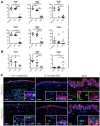Age-related changes in expression and function of Toll-like receptors in human skin
- PMID: 23034637
- PMCID: PMC3912866
- DOI: 10.1242/dev.083477
Age-related changes in expression and function of Toll-like receptors in human skin
Abstract
Toll-like receptors (TLRs) initiate innate immune responses and direct subsequent adaptive immunity. They play a major role in cutaneous host defense against micro-organisms and in the pathophysiology of several inflammatory skin diseases. To understand the role of TLRs in the acquisition of immunological competence, we conducted a comprehensive study to evaluate TLR expression and function in the developing human skin before and after birth and compared it with adults. We found that prenatal skin already expresses the same spectrum of TLRs as adult skin. Strikingly, many TLRs were significantly higher expressed in prenatal (TLRs 1-5) and infant and child (TLRs 1 and 3) skin than in adult skin. Surprisingly, neither dendritic cell precursors in prenatal skin nor epidermal Langerhans cells and dermal dendritic cells in adult skin expressed TLRs 3 and 6, whereas the staining pattern and intensity of both TLRs in fetal basal keratinocytes was almost comparable to those of adults. Stimulation of primary human keratinocytes from fetal, neonatal and adult donors with selected TLR agonists revealed that the synthetic TLR3 ligand poly (I:C) specifically, mimicking viral double-stranded RNA, induced a significantly enhanced secretion of CXCL8/IL8, CXCL10/IP-10 and TNFα in fetal and neonatal keratinocytes compared with adult keratinocytes. This study demonstrates quantitative age-specific modifications in TLR expression and innate skin immune reactivity in response to TLR activation. Thus, antiviral innate immunity already in prenatal skin may contribute to protect the developing human body from viral infections in utero in a scenario where the adaptive immune system is not yet fully functional.
Figures




References
-
- Abtin A., Eckhart L., Gläser R., Gmeiner R., Mildner M., Tschachler E. (2010). The antimicrobial heterodimer S100A8/S100A9 (calprotectin) is upregulated by bacterial flagellin in human epidermal keratinocytes. J. Invest. Dermatol. 130, 2423-2430 - PubMed
-
- Angelone D. F., Wessels M. R., Coughlin M., Suter E. E., Valentini P., Kalish L. A., Levy O. (2006). Innate immunity of the human newborn is polarized toward a high ratio of IL-6/TNF-alpha production in vitro and in vivo. Pediatr. Res. 60, 205-209 - PubMed
-
- Belderbos M. E., van Bleek G. M., Levy O., Blanken M. O., Houben M. L., Schuijff L., Kimpen J. L., Bont L. (2009). Skewed pattern of Toll-like receptor 4-mediated cytokine production in human neonatal blood: low LPS-induced IL-12p70 and high IL-10 persist throughout the first month of life. Clin. Immunol. 133, 228-237 - PMC - PubMed
-
- Blauvelt A., Glushakova S., Margolis L. B. (2000). HIV-infected human Langerhans cells transmit infection to human lymphoid tissue ex vivo. AIDS 14, 647-651 - PubMed
Publication types
MeSH terms
Substances
Grants and funding
LinkOut - more resources
Full Text Sources
Other Literature Sources
Medical

